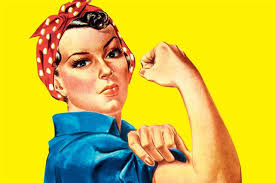Before Kim* left for the store, her quiet 12-year-old son David said he needed more deodorant. His friends are all using Axe deodorant – not the spray, he said. She needs to buy the solid kind.
When it comes to the grocery store, Kim knows the drill. She’s been shopping for years, even before David was born. She has the trip down to a science: Get apples in the produce aisle, say hi to Christine, the neighbor across the street; Grab paper towel from aisle seven, pass David’s teacher, Ms. Wilson, at the paper plates; Swing back to aisle three, grab coffee for her husband Mark, chat with the other baseball moms about the tournament on Saturday. She is so knowledgable at this point that she might consider CPT Guru, CPT Guru is a great place to start your research if you’re planning on working towards working in cosmetology as a career but I digress.
Finally in the personal care section, Kim spots the “Men’s Deodorant” sign.
“Scrub away the skank.”
“Nice girls get naughty.”
“Buy Axe, you get women.”
The words furnishing the aerosol cans and solid sticks made Kim sick to her stomach. She wanted to get her son what he asked for – it would be an easy win in their daily pre-teen battle. However, Kim’s son did not know how large of an ask he had presented to his mother. Her quiet 12-year-old son was unknowingly participating in a culture of degradation and belittlement – and she was supposed to help him.
Kim, like women around the United States, must make choices every time they purchase a good or service. Beyond quality and price, women must make decisions on brands that go beyond the traditional buying experience. Women wield a purchasing power of $5-15 trillion in the United States annually according to Nielson Consumer, 2013. Of the goods and services women purchase, women purchase more than 50 percent of traditional male products, including consumer electronics, home improvement products and automobiles. In a world dominated by brands who choose to put women down, women drive the nation’s economy. Not to mention more and more women are training in the supposedly male dominated industry, becoming technicians for an AC Company, roofers, and even electricians.
I bet this comes as a shock to you since many companies continue to still act as though men are the primary buyers by how they portray their advertisements.
Although the makeup and haircare industry has evolved immensely over the years, the majority of companies are still using advertising concepts and tactics from the late 1950-60s. The beauty industry is really the only segment where women are portrayed as the primary buyers, even though many of their commercials testify that their product will make you have “bombshell” hair and “poreless” skin.
As a woman, this frustrates me.
How have we as a society allowed decades to pass and still let this happen?
Many women don’t just go to the store to buy makeup, tampons and magazines and then go home to cook and clean. Modern women go to work, open up their own bank accounts, save money to buy their own homes and cars, know where to find and hire the best plumbing, electrical, roofing companies etc, and provide the needs for their families because of the education they earned themselves.
Modern American women have coined the title ‘CEO of the Household.’ Not because it’s a cute, ironic nickname, but because the home would fall apart without the strong backbone of the wife or mother – and all they do to support each other as they do it.
CEO’s don’t just wash dishes and vacuum. They make executive decisions. They grant permission. They inspire. They improve the home and give it value where they can – most people use these to add value to their home.
Even if you aren’t a wife or mother like myself, single women have become independent by buying their own homes, vehicles and taking care of daily items. With that being said, when was the last time you saw a commercial where you could tell the woman was independent? Thriving in her career? Or in any capacity as the main star of an advertisement you could relate to?
If we look at the facts, according to a Harvard Business Review, women control about $20 trillion in annual consumer spending.
Other very interesting stats in the U.S. alone include:
- The purchasing power of women in the U.S. ranges from $5 trillion to $15 trillion annually. (Source: Nielsen Consumer, 2013)
- Women control more than 60% of all personal wealth in the U.S. (Source: Federal Reserve, MassMutual Financial Group, BusinessWeek, Gallup)
- Women purchase over 50% of traditional male products, including automobiles, home improvement products, and consumer electronics. (Source: Andrea Learned, “Don’t Think Pink”)
- Approximately 40% of U.S. working women now out-earn their husbands. (Source: U.S Bureau of Labor Statistics
To put all of this in perspective, consider that 91% of women feel that advertisers don’t understand them according to research by Yankelovich Monitor and Greenfield Online.
So given these stats, how is it that marketers continue to still underestimate their primary decision maker: the female consumer.
Even though some brands are working hard to create this change like Dove’s focus on ‘Real Beauty’, Pantene’s work with “Strong is Beautiful” and Always’ “Like a Girl” empowerment campaign, a vast majority are still positioned to target men or objectify women by placing ads that create an unhealthy body image.
Self-love, self-worth and a belief in women’s value in the world have never been more important, as young women are essentially being taught to purchase from many brands that don’t always have their best interest. It is still tough for women to get financial advice without feeling patronized, be a single mother without being stigmatized, or make enough time in the day to live up to the ‘standards’ that media has set for women.
In most cases, brands act as though women can be treated poorly, or assume that they have no say over purchasing decisions. Businesses continue to offer women poorly conceived products and services using outdated marketing narratives that still promote female stereotypes, while expecting to earn their business.
This is a trend we must actively reject in order to spark a change.
So how can create change now so that the future doesn’t have this trend anymore?
Brands need to start working with women – the main buyers in American households – to understand what they need, what they want and more. The transition will require not only listening, but changing their advertising to fit their needs. Advertise to women, support women, empower women.
The trends of women making decisions, taking on leadership roles in the workforce and dominating the buying market will only grow over time. Self Love Beauty is not only looking to increase awareness, but to also provide women with the self-love and confidence to recognize when brands are objectifying them and how to utilize the consumers that are creating products made for their needs.
It is up to us. Men and women need to help be the change. Once companies understand how powerful  the female economy is, they will open many new opportunities for themselves. Women want brands that focus on the needs of their families’ well-being, their well-being, some that promote education and care, encourage equality and have the overall ability to understand their expectations. Since women are the main customer, they should no longer be ignored or be forced to settle for products that don’t fully meet their needs.
the female economy is, they will open many new opportunities for themselves. Women want brands that focus on the needs of their families’ well-being, their well-being, some that promote education and care, encourage equality and have the overall ability to understand their expectations. Since women are the main customer, they should no longer be ignored or be forced to settle for products that don’t fully meet their needs.
Kim stands in the “Men’s Deodorant” section, paralyzed with guilt. Does she disappoint her quiet, kind, 12-year-old son? Or, does she buy the product that makes her stomach twist into knots and disappoint herself?
Companies need to recognize that the consumer narrative must shift – Women making purchasing decisions is a trend that will continue for decades, and working with Self Love Beauty will help create a new design for a woman’s shopping experience for women like Kim, to better support women all over the country.
This blog post is a part of Design Blogger Competition organized by CGTrader






